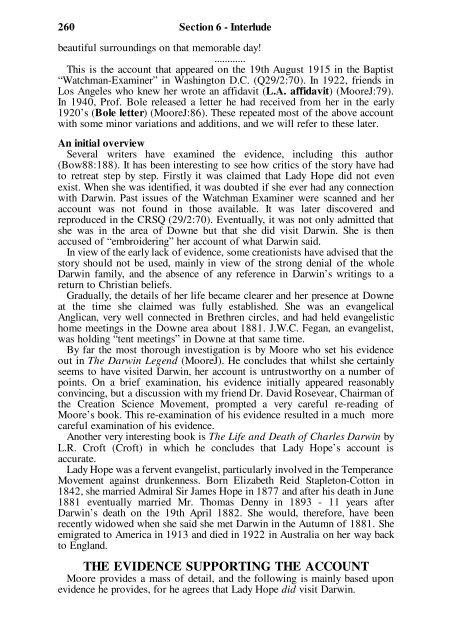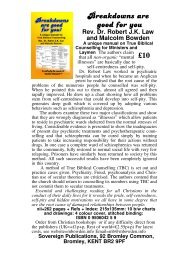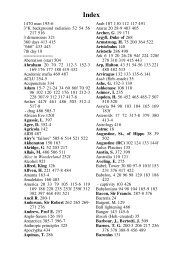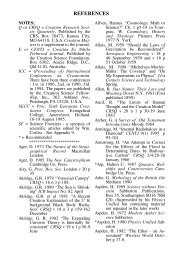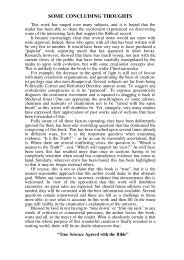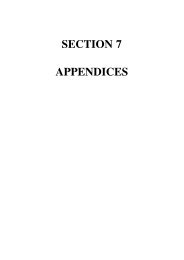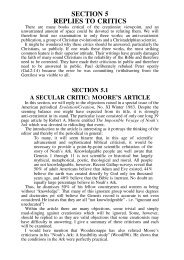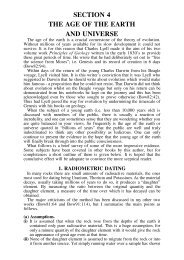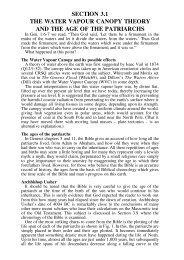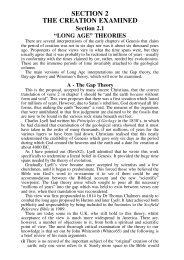TSAWTB Section 6 - Interlude - A Miscellany of Items
True Science Agrees with the Bible, Section 6 - Interlude - A Miscellany of Items (pp. 250-288)
True Science Agrees with the Bible, Section 6 - Interlude - A Miscellany of Items (pp. 250-288)
You also want an ePaper? Increase the reach of your titles
YUMPU automatically turns print PDFs into web optimized ePapers that Google loves.
260 <strong>Section</strong> 6 - <strong>Interlude</strong><br />
beautiful surroundings on that memorable day!<br />
............<br />
This is the account that appeared on the 19th August 1915 in the Baptist<br />
“Watchman-Examiner” in Washington D.C. (Q29/2:70). In 1922, friends in<br />
Los Angeles who knew her wrote an affidavit (L.A. affidavit) (MooreJ:79).<br />
In 1940, Pr<strong>of</strong>. Bole released a letter he had received from her in the early<br />
1920’s (Bole letter) (MooreJ:86). These repeated most <strong>of</strong> the above account<br />
with some minor variations and additions, and we will refer to these later.<br />
An initial overview<br />
Several writers have examined the evidence, including this author<br />
(Bow88:188). It has been interesting to see how critics <strong>of</strong> the story have had<br />
to retreat step by step. Firstly it was claimed that Lady Hope did not even<br />
exist. When she was identified, it was doubted if she ever had any connection<br />
with Darwin. Past issues <strong>of</strong> the Watchman Examiner were scanned and her<br />
account was not found in those available. It was later discovered and<br />
reproduced in the CRSQ (29/2:70). Eventually, it was not only admitted that<br />
she was in the area <strong>of</strong> Downe but that she did visit Darwin. She is then<br />
accused <strong>of</strong> “embroidering” her account <strong>of</strong> what Darwin said.<br />
In view <strong>of</strong> the early lack <strong>of</strong> evidence, some creationists have advised that the<br />
story should not be used, mainly in view <strong>of</strong> the strong denial <strong>of</strong> the whole<br />
Darwin family, and the absence <strong>of</strong> any reference in Darwin’s writings to a<br />
return to Christian beliefs.<br />
Gradually, the details <strong>of</strong> her life became clearer and her presence at Downe<br />
at the time she claimed was fully established. She was an evangelical<br />
Anglican, very well connected in Brethren circles, and had held evangelistic<br />
home meetings in the Downe area about 1881. J.W.C. Fegan, an evangelist,<br />
was holding “tent meetings” in Downe at that same time.<br />
By far the most thorough investigation is by Moore who set his evidence<br />
out in The Darwin Legend (MooreJ). He concludes that whilst she certainly<br />
seems to have visited Darwin, her account is untrustworthy on a number <strong>of</strong><br />
points. On a brief examination, his evidence initially appeared reasonably<br />
convincing, but a discussion with my friend Dr. David Rosevear, Chairman <strong>of</strong><br />
the Creation Science Movement, prompted a very careful re-reading <strong>of</strong><br />
Moore’s book. This re-examination <strong>of</strong> his evidence resulted in a much more<br />
careful examination <strong>of</strong> his evidence.<br />
Another very interesting book is The Life and Death <strong>of</strong> Charles Darwin by<br />
L.R. Cr<strong>of</strong>t (Cr<strong>of</strong>t) in which he concludes that Lady Hope’s account is<br />
accurate.<br />
Lady Hope was a fervent evangelist, particularly involved in the Temperance<br />
Movement against drunkenness. Born Elizabeth Reid Stapleton-Cotton in<br />
1842, she married Admiral Sir James Hope in 1877 and after his death in June<br />
1881 eventually married Mr. Thomas Denny in 1893 - 11 years after<br />
Darwin’s death on the 19th April 1882. She would, therefore, have been<br />
recently widowed when she said she met Darwin in the Autumn <strong>of</strong> 1881. She<br />
emigrated to America in 1913 and died in 1922 in Australia on her way back<br />
to England.<br />
THE EVIDENCE SUPPORTING THE ACCOUNT<br />
Moore provides a mass <strong>of</strong> detail, and the following is mainly based upon<br />
evidence he provides, for he agrees that Lady Hope did visit Darwin.


